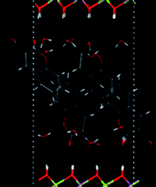This paper describes a systematic investigation on the photophysical properties, thermal stability, and orientational structure of a coumarin-3-carboxylate (C3C) and dodecylsulfonate (DDS) co-intercalated Mg-Al-layered double hydroxide (C3C-DDS/LDH) system. C3C and DDS with different molar ratios were co-intercalated into the interlayer region of Mg-Al-LDH. The structures of the composites were characterized by X-ray diffraction (XRD), thermogravimetric and differential thermal analysis (TG-DTA). Fluorescence spectra demonstrate that the sample with 1.96% C3C molar percentage (with respect to the total organic components) exhibits the optimal luminous intensity. The fluorescence lifetime of C3C in C3C-DDS/LDH is enhanced significantly compared with that of pristine C3C solution (5.52 ns vs. 2.70 ns), revealing that the co-intercalation method is favorable for the improvement of the luminescence performances of the dye. C3C-DDS/LDH thin film was fabricated by the solvent evaporation method, which exhibits well polarized luminescence with the luminescent anisotropy of 0.10–0.15 at ambient temperature. Furthermore, molecular dynamics (MD) simulation was employed to calculate the basal spacing and molecular arrangement of intercalated C3C and DDS in the LDH matrix. The simulation results show that the intercalated C3C anions exhibit a tendency from tilted to vertical orientation relative to the inorganic layers as the interlayer DDS content increases. Moreover, the increase of the distance between C3C anions can be achieved enough upon the co-intercalation of DDS, presenting the key role of surfactant for preventing dye aggregation. Based on the combination of experimental and simulated studies, the photoluminescence properties of the C3C-DDS/LDH thin film were deeply studied and optimized, and a detailed understanding of the orientation of two individual guest molecules confined within the galleries of host layers was achieved.

You have access to this article
 Please wait while we load your content...
Something went wrong. Try again?
Please wait while we load your content...
Something went wrong. Try again?


 Please wait while we load your content...
Please wait while we load your content...